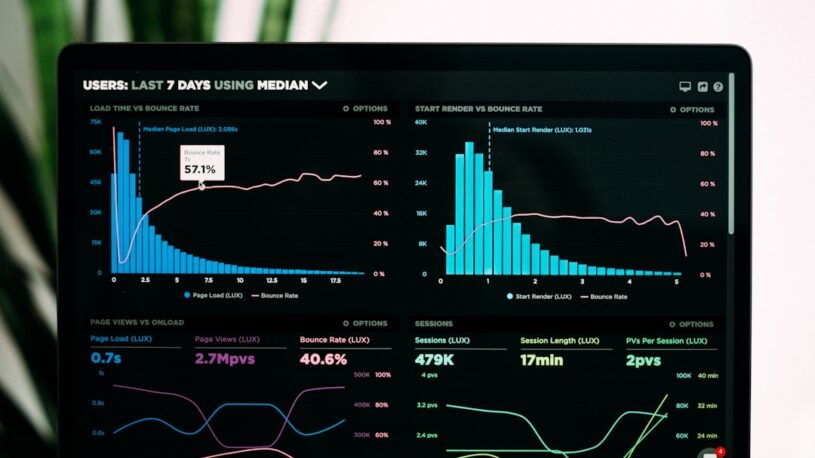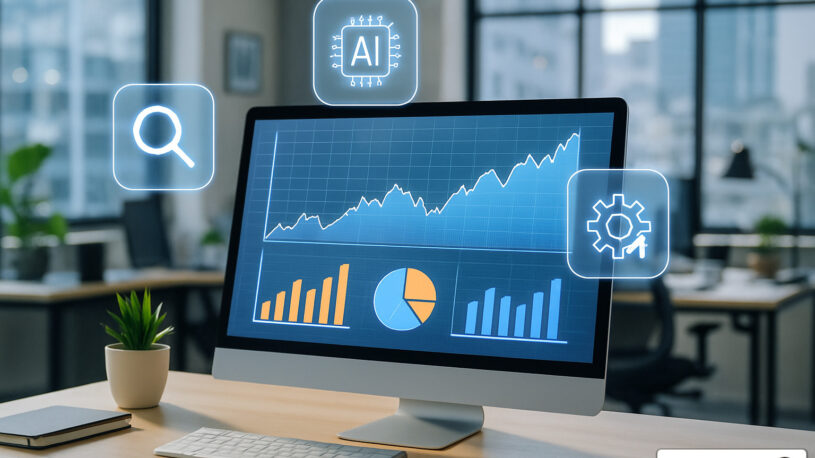

Automate or Stagnate – Why AI is Essential for Business Processes
Changing Business Operations with AI
Ever wonder what happens when artificial intelligence meets your everyday business processes? Something pretty amazing, actually.
AI business process automation transforms how companies operate by bringing intelligence to workflows that once required constant human oversight. It’s like giving your business operations a brain upgrade – one that learns, adapts, and gets smarter over time.
At its core, this technology combines the learning capabilities of AI with traditional automation to create systems that don’t just follow rules but actually understand what they’re doing. By leveraging machine learning, natural language processing, and computer vision, these systems can take on complex tasks that previously seemed impossible to automate.
For business leaders trying to make sense of this technology, here’s a simple breakdown of what you need to know:
| AI Business Process Automation Essentials | Description |
|---|---|
| Definition | Technologies that use AI to automate complex business processes, enabling systems to learn, adapt, and make decisions with minimal human intervention |
| Key Components | Machine learning, natural language processing, computer vision, robotic process automation (RPA), data analytics |
| Primary Benefits | 60-70% time savings per employee, 30-50% reduction in forecasting errors, 44% of businesses report lower operational costs |
| Top Use Cases | Customer service automation, intelligent document processing, predictive maintenance, fraud detection, supply chain optimization |
| Implementation Approach | Start with process assessment, run small pilots, ensure data quality, integrate with existing systems, scale successful projects |
In today’s competitive landscape, implementing AI business process automation isn’t just a nice-to-have efficiency boost – it’s becoming essential for survival. Companies that accept these technologies gain a significant edge over those still relying on manual processes or basic automation.
The numbers tell a compelling story. According to McKinsey research, “Generative AI and automation can potentially save up to 60 to 70% of an employee’s time, boosting productivity.” That’s not a small improvement – it’s a fundamental shift in what your team can accomplish.
What makes this technology special is how it evolves beyond traditional automation. Where older systems followed rigid, unchanging rules, AI-powered automation brings a new level of flexibility and intelligence. Your processes become smarter because they can:
Learn from experience, getting better with each task they complete
Handle messy, unstructured information like emails and documents
Make educated predictions based on patterns in your data
Adapt to changing conditions without requiring reprogramming
Perhaps the best news? This technology is no longer just for giant corporations with massive IT budgets. Cloud-based AI services and user-friendly platforms have democratized access, making sophisticated automation accessible to businesses of all sizes. You don’t need a team of data scientists to start changing your operations today.
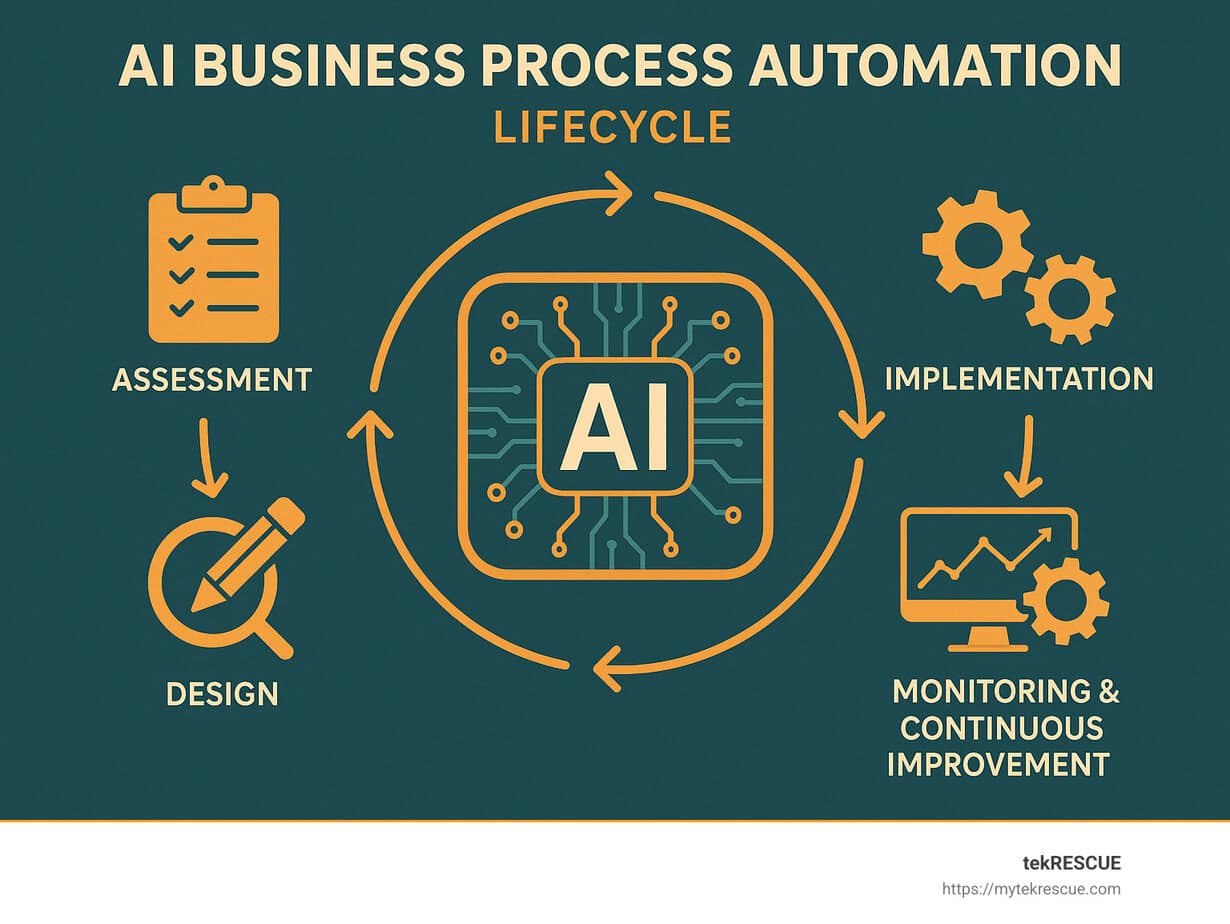
What Is AI Business Process Automation?
AI business process automation takes traditional business processes to the next level by adding a brain to the operation. Unlike old-school automation that simply follows rigid rules like a robot, AI-powered automation can actually learn, adapt, and make smart decisions based on what it sees in your data.
Think of it this way: traditional automation is like a train that can only follow its tracks, while AI business process automation is more like a self-driving car that can steer changing conditions and find better routes along the way.
Gartner describes these systems perfectly: adaptive AI “supports a decision-making framework centered around making faster decisions while remaining flexible to adjust as issues arise. These systems aim to continuously learn based on new data at runtime to adapt more quickly to changes in real-world circumstances.”
This intelligence transforms automation from a simple task-runner into a sophisticated system that handles complex processes and even suggests improvements. It’s like upgrading from a basic calculator to having a math genius on your team.
| Aspect | Traditional BPA | AI BPA |
|---|---|---|
| Decision-making | Rule-based, predetermined | Adaptive, learns from data |
| Data handling | Structured data only | Structured and unstructured data |
| Process complexity | Simple, repetitive tasks | Complex, variable workflows |
| Adaptability | Requires manual updates | Self-improving through ML |
| Human interaction | Limited, scripted | Natural language, context-aware |
| Error handling | Stops at exceptions | Can handle exceptions and variations |
| Improvement | Manual optimization | Continuous self-optimization |
| Business value | Efficiency | Efficiency + insights + innovation |
The magic behind AI business process automation comes from several powerful technologies working together:
Machine Learning (ML) allows systems to learn from data and get smarter over time, much like how we learn from experience. Natural Language Processing (NLP) gives automation the ability to understand and respond to human language, making interaction more natural. Computer Vision lets systems “see” and make sense of visual information like documents or images.
These advanced capabilities work alongside more traditional tools like Robotic Process Automation (RPA) (software robots that mimic human actions), Process Mining (which analyzes how your processes actually work), and Workflow Orchestration (which coordinates all the moving parts).
Together, this technology cocktail creates powerful systems that can transform virtually any business operation across any industry.
Key Differences Between BPA, RPA, and AI BPA
Understanding the different flavors of automation helps you pick the right approach for your business needs:
Business Process Automation (BPM) focuses on the big picture of workflows. It’s like having a conductor who oversees the entire orchestra from beginning to end, making sure everything flows smoothly.
Robotic Process Automation (RPA) is more like having a really efficient assistant who’s great at repetitive tasks. These software “robots” handle specific, rule-based activities like data entry, but they’re not particularly adaptable or smart.
AI Business Process Automation combines the best of both worlds and adds that critical intelligence layer. It’s like having both the conductor and the assistant, plus a strategic advisor who learns from experience and can handle complex situations.
This intelligent approach means your automation can now work with messy, real-world data like emails and documents, make smart decisions based on multiple factors, learn and improve over time, adapt to changes without needing reprogramming, understand natural conversations, and even predict future outcomes.
As Etienne Kneschke from KARL STORZ puts it: “Process intelligence is the foundational enabler of generative AI-based automation in enterprises, as it feeds LLMs with the essential contextual understanding they need, in order to know how the business runs across systems, departments, and regions.”
This contextual understanding is what makes AI business process automation so powerful. While simple RPA might automate data entry, AI-powered automation understands the broader business context and can make intelligent decisions that align with your goals and processes. It doesn’t just do tasks faster—it helps you work smarter.
7 Game-Changing Benefits of AI-Powered Process Automation
The transformative impact of AI business process automation extends far beyond simple efficiency gains. Here are seven ways AI is revolutionizing business operations:

When businesses implement AI-powered automation, they’re not just speeding up existing processes—they’re fundamentally changing how work gets done. The benefits touch every aspect of an organization, from the bottom line to employee satisfaction and customer experience.
Let’s explore what makes AI business process automation such a game-changer for today’s businesses:
Productivity skyrockets when AI handles routine tasks. Studies show that organizations can achieve an impressive 60-70% time savings per employee. That’s not just incremental improvement—it’s changeal efficiency that frees your team to focus on creative, strategic work that machines simply can’t do.
Cost reduction is a primary driver for adoption, with 44% of business leaders reporting significant operational savings after implementation. Cloud-based AI solutions offer pay-as-you-go models that make these technologies accessible even for smaller organizations without massive upfront investments.
Accuracy reaches new heights when AI systems process data and execute tasks. Unlike humans who fatigue or get distracted, AI maintains consistent precision 24/7, dramatically reducing error rates in everything from data entry to complex calculations.
Compliance becomes more robust and less burdensome. AI systems create detailed audit trails automatically and can spot potential regulatory issues before they become problems. This proactive approach is especially valuable in highly regulated industries like finance and healthcare.
Customer experience transforms when AI personalizes interactions and provides instant, 24/7 service. Natural language processing enables more human-like conversations, while sentiment analysis helps route customers to the right resources based on their emotional state.
Innovation accelerates as teams gain access to real-time analytics and predictive insights. With 30-50% fewer forecasting errors, businesses can make more confident decisions and spot opportunities competitors might miss.
Scalability becomes seamless when AI handles fluctuating workloads. Whether you’re experiencing seasonal spikes or rapid growth, AI systems can scale instantly without the hiring, training, and retention challenges of expanding a human workforce.
The sustainability impact shouldn’t be overlooked either. By optimizing resource usage and reducing waste, AI business process automation helps organizations meet environmental goals while cutting costs—a true win-win.
As you consider these benefits, implementation doesn’t have to be all-or-nothing. Many organizations start with specific, high-impact processes and gradually expand their automation footprint as they build confidence and expertise. The key is getting started and learning as you go.
1. Turbocharged Efficiency
AI business process automation doesn’t just speed things up—it transforms how work gets done. By eliminating bottlenecks, cutting manual tasks, and enabling round-the-clock operations, businesses can achieve remarkable productivity gains that were previously unimaginable.
Think about it: while your human team needs breaks, sleep, and well-deserved vacations, your AI systems are happily processing work 24/7 without complaint. This continuous operation capability is a game-changer for businesses facing tight deadlines or global operations.
The numbers tell a compelling story. According to McKinsey’s research, generative AI and automation can potentially save up to 60-70% of an employee’s time. That’s not just shaving a few minutes here and there—it’s liberating more than half of your team’s working hours for higher-value activities.
One leading US bank finded this when they reimagined their annual reporting process. By combining smart process orchestration with AI capabilities, they slashed their reporting time from six long weeks to less than one week. This 85% reduction didn’t just speed things up—it freed valuable resources while simultaneously improving accuracy and regulatory compliance.
As one financial services executive so perfectly put it: “We’re not just doing the same things faster—we’re completely reimagining our workflows based on what AI makes possible.”
This reimagining is at the heart of true efficiency gains. It’s not about making people work faster under pressure; it’s about intelligent systems handling routine tasks so your team can focus on creative problem-solving, relationship building, and strategic thinking—the things humans do best.
When implemented thoughtfully, ai business process automation creates a virtuous cycle: processes become faster, which reduces costs, which enables investment in further improvements, which creates even greater efficiency. The key is starting with a clear understanding of your current workflows and identifying where AI can make the biggest impact.
2. Cost Savings & Faster ROI
Money talks, and when it comes to ai business process automation, it’s saying all the right things. According to recent research, a remarkable 44% of business leaders have reported reduced operational costs after implementing AI solutions in their workflows.
These savings don’t just come from one source – they flow from multiple streams throughout your business:
When your team spends less time on routine tasks, your labor costs naturally decrease. With AI handling repetitive work, human errors (and their costly fixes) become far less common. Your operational overhead shrinks as processes become streamlined, and you’ll find yourself spending less on training for basic tasks. Perhaps best of all, your valuable human resources can be allocated to work that actually requires human creativity and problem-solving.
“We expected some cost savings when we implemented AI automation, but we were honestly shocked by how quickly it paid for itself,” shares one operations director at a mid-sized retail company. “The ROI wasn’t measured in years – it was measured in months.”
The cloud has completely changed the game for businesses considering ai business process automation. Instead of massive upfront investments in hardware and software, cloud-based AI services let you pay only for what you actually use. This “pay-as-you-go” approach has democratized access to sophisticated automation tools, making them available to businesses of all sizes – not just enterprise giants with deep pockets.
Consider the real-world example of a mid-sized manufacturing company that implemented AI-driven quality control. Within just the first quarter, they reduced defect rates by 32%, delivering complete ROI in only 90 days. Their system quickly paid for itself through reduced waste and fewer warranty claims, while simultaneously boosting customer satisfaction. That’s the definition of a win-win.
For smaller businesses wondering if ai business process automation is worth the investment, the evidence points to a resounding yes – especially when you focus on processes with clear, measurable costs that can be optimized through intelligent automation.
3. Decision Quality & Predictive Insights
Have you ever wished you could see into the future? While AI business process automation can’t quite give you a crystal ball, it comes remarkably close by changing mountains of data into actionable insights that improve decision-making across your organization.
Think about this: AI systems reduce forecasting errors by 30-50% in supply chain management. That’s not magic—it’s the power of machine learning to spot patterns that even your most experienced team members might miss. These systems adapt to changing conditions on the fly, giving you a real competitive edge when market conditions shift unexpectedly.
Behind the scenes, data fabric technology works like a digital librarian, pulling information from all your different systems without requiring expensive, time-consuming data migration projects. This gives your AI tools access to the complete picture—enterprise-wide information in real time—so decisions are based on all available facts, not just fragments.
The results can be transformative. One retail chain we worked with implemented AI-powered demand forecasting and saw inventory costs drop by 23% while simultaneously reducing stockouts by 17%. That’s the kind of dual benefit that traditional approaches simply can’t deliver—lower costs AND better customer experience at the same time.
What makes these predictive insights so valuable is how they integrate with your existing business processes. Rather than delivering insights that sit unused in reports, AI business process automation weaves intelligence directly into your workflows. When the system spots an opportunity or identifies a potential issue, it can either take action automatically or alert the right person with specific recommendations.
This creates a virtuous cycle where better decisions lead to better data, which in turn powers even more accurate predictions. Your business becomes not just more efficient, but genuinely smarter over time—learning from every transaction, customer interaction, and market shift.
4. Improved Customer Experiences
Customer expectations have completely changed in the digital age. People don’t just want service—they want personalized, immediate attention at any hour. This is where AI business process automation truly shines.
Think about how frustrating it is when you need help outside business hours and hit a wall. AI-powered systems eliminate this problem by providing 24/7 service through intelligent chatbots that actually understand what customers are asking. These aren’t your clunky, script-following bots of the past—they use natural language processing to grasp intent and context.
A telecommunications company we worked with saw remarkable results after implementing AI chatbots. These digital assistants now handle nearly 70% of customer inquiries without human intervention. The beauty is that they’re constantly learning from each interaction, getting smarter and more helpful over time.
AI business process automation transforms customer experiences in several powerful ways:
Personalization becomes scalable when AI analyzes customer data to deliver custom recommendations and solutions. It’s like having a personal shopper who remembers everything about you, but for every customer simultaneously.
Sentiment analysis is particularly impressive—AI can detect frustration, confusion, or satisfaction in customer communications and adjust responses accordingly. When a customer is upset, the system can prioritize their issue or route them to specialized support.
What makes this technology truly is its ability to handle unstructured data—those messy, real-world communications like rambling emails, social media comments, and actual phone conversations. AI makes sense of this chaos, extracting meaning and responding appropriately.
Many businesses worry that automation might feel cold or impersonal. The reality is quite the opposite. By handling routine inquiries automatically, AI frees up human agents to focus on complex issues that require empathy and creative problem-solving. The result? More meaningful human connections where they matter most.
For businesses looking to improve customer satisfaction while controlling costs, AI business process automation offers the best of both worlds—better service that’s also more efficient. It’s not about replacing the human touch but enhancing it by removing friction and delivering faster, more consistent responses.
5. Compliance & Risk Management
Let’s face it—staying compliant can feel like a never-ending game of catch-up, especially in heavily regulated industries. But here’s where AI business process automation really shines by turning compliance from a dreaded cost center into a genuine strategic advantage.
Think about what happens when AI takes over your compliance efforts. Instead of scrambling to keep up with regulatory changes, your systems automatically create comprehensive audit trails as they work. No more missing documentation or scrambling before audits!
One of the most valuable aspects is how AI constantly monitors for unusual patterns. Those subtle anomalies that might indicate fraud or errors? Your AI system spots them when human reviewers might miss them entirely. It’s like having a vigilant guardian watching every transaction 24/7.
For financial institutions preparing for regulations like the EU’s Digital Operational Resilience Act (DORA), this capability isn’t just nice to have—it’s becoming essential. The adaptive controls in modern AI business process automation systems can flex and adjust as regulatory requirements evolve, keeping you compliant without constant manual intervention.
A real-world example shows just how powerful this can be: a leading insurance company implemented AI-driven compliance monitoring that slashed their manual review time by a whopping 85%. The kicker? They simultaneously improved their detection rates for suspicious transactions. The system flags potential issues for human review, giving them the perfect blend of AI efficiency with human judgment.
What makes this approach particularly effective is how it balances automation with human oversight. The AI handles the heavy lifting—monitoring transactions in real time and automatically generating reports for regulatory authorities—while your team focuses on addressing genuine issues rather than drowning in paperwork.
The result isn’t just better compliance; it’s smarter risk management across your entire organization with fewer resources and less stress. Now that’s something worth implementing!
6. Workforce Empowerment & Upskilling
When people hear “AI business process automation,” they often worry about robots taking their jobs. The reality is quite different—and much more positive.
Instead of replacing humans, good AI implementation actually empowers your team by taking the mind-numbing, repetitive tasks off their plates. Think about it: would your accounting team rather spend their days manually entering invoice data or using their expertise to spot financial opportunities?
The numbers back this up too. Research shows that a whopping 88% of employees feel more productive when using AI assistants and copilots in their daily work. These tools aren’t replacing workers—they’re supercharging what humans can accomplish.
One HR director we worked with put it perfectly: “When we first announced AI automation, you could feel the tension in the room. Six months later? The same team was asking why we hadn’t done it sooner. Nobody misses spending half their day on paperwork.”
The key is thoughtful implementation. Successful companies don’t just drop AI tools on employees’ desks and walk away. They invest in proper change management and training programs that help their teams develop new skills for the AI-augmented workplace. This might include:
- Training on how to effectively prompt and interact with AI tools
- Workshops on critical thinking and evaluating AI outputs
- Opportunities to learn more strategic aspects of their roles
This investment in human capital pays huge dividends. When employees aren’t bogged down in manual processes, they have mental space for innovation, problem-solving, and building better customer relationships—things AI can’t do.
The most successful AI business process automation projects accept this human-AI partnership model. The AI handles the routine, predictable work while humans provide judgment, creativity, and emotional intelligence. It’s not about replacing people—it’s about helping them work on higher-value activities that actually use their full potential.
As businesses continue adopting these technologies, the most valuable employees won’t be those who resist change, but those who learn to work alongside AI tools, directing and enhancing their capabilities while focusing their own efforts where human skills truly shine.
7. Foundation for New Business Models
When you implement AI business process automation, you’re not just improving what you already do—you’re opening doors to entirely new ways of doing business that simply weren’t possible before.
Think of it as building a launchpad for innovation. With intelligent, adaptive systems handling your core processes, your team can explore opportunities that once seemed out of reach.
Hyperautomation is where the magic really happens. By combining multiple AI, machine learning, and RPA technologies, you create seamless end-to-end workflows that can transform your entire operation. This isn’t just about making things faster—it’s about making the impossible possible.
Agentic AI takes this evolution even further. These systems can make autonomous decisions within boundaries you set, essentially becoming digital team members that handle complex tasks without constant supervision. They learn, adapt, and improve over time, just like your human employees.
What’s particularly exciting is how accessible these powerful tools have become. Low-code/no-code platforms now put AI business process automation capabilities in the hands of regular business users—not just IT specialists or data scientists. Your marketing team, HR department, or finance group can build their own intelligent automation without writing a single line of code.
This democratization is driving massive growth. The global no-code AI platform market is expected to surge from about $4.77 billion in 2025 to a whopping $37.96 billion by 2033. Businesses of all sizes are jumping on board, recognizing that they don’t need massive tech departments to leverage AI.
Perhaps most valuable is how these technologies enable platform ecosystems. Your business can rapidly develop and deploy new services, respond to market changes on the fly, and scale operations without the traditional headaches of hiring sprees or spiraling costs.
A manufacturing client recently told me, “We started automating to cut costs, but ended up creating three entirely new service lines that now account for 20% of our revenue. We never saw that coming.” That’s the real power of AI business process automation—it’s not just about doing things better, but about doing better things.
Types and Levels of Automation: From Tasks to Hyperautomation
AI business process automation isn’t one-size-fits-all. It’s more like a journey with several stops along the way, each offering different capabilities and benefits. Understanding where your business fits on this spectrum helps you chart a realistic path forward.

Task Automation
Think of task automation as the entry point – it’s where most businesses begin their automation journey. Here, we’re talking about those repetitive, mundane tasks that eat up your team’s time and energy – data entry, form filling, simple calculations, and document generation.
RPA (Robotic Process Automation) shines in this space, creating digital workers that follow the same steps a human would. It’s like having a tireless assistant who never makes typos or gets distracted.
The limitation? These digital helpers aren’t particularly bright. They follow instructions perfectly but can’t adapt when something unexpected happens. They’re like GPS systems that keep telling you to “turn right” even when the road is closed for construction.
Workflow Automation
Moving up a level, workflow automation connects those individual automated tasks into a coherent process. Instead of isolated digital helpers, you now have an orchestra playing together under the direction of BPM (Business Process Management) platforms or workflow engines.
This is where the magic starts to happen. Documents move automatically between departments. Approvals route themselves to the right people. Notifications trigger at exactly the right moment. The whole process becomes visible, measurable, and consistent.
But traditional workflow automation still plays by rigid rules. It knows the happy path but struggles when exceptions arise – and in business, exceptions are the rule, not the exception!
Intelligent Process Automation (IPA)
This is where AI enters the picture in a big way. Intelligent Process Automation marries the reliability of RPA with the adaptability of AI technologies like machine learning and natural language processing.
Suddenly, your automation can handle messy, real-world data. Those handwritten forms? No problem. Customer emails with vague requests? It can figure those out too. And most importantly, it learns from experience, getting smarter over time.
The IPA market is booming, growing at over 13% annually and expected to reach $37 billion by 2030. Why? Because it tackles the complex, variable processes that previous automation couldn’t touch – customer onboarding that adapts to different situations, claims processing that spots potential fraud, supply chains that reroute themselves around problems.
Hyperautomation
At the summit of our automation mountain sits hyperautomation – Gartner’s term for the comprehensive approach that combines multiple technologies into an end-to-end automation ecosystem.
Hyperautomation isn’t just about doing the same things faster. It’s about fundamentally changing how business operates by weaving together AI, ML, RPA, process mining, and analytics into a seamless whole.
The key components that make hyperautomation so powerful include:
Process Intelligence that constantly analyzes workflows to find bottlenecks and opportunities for improvement. Agentic AI that makes decisions independently within guardrails you define. Generative AI that creates content, designs interfaces, and even writes code based on simple prompts. IoT Integration that connects physical devices to your automation platform, bringing real-world data into your digital processes. And Blockchain technologies that create secure, transparent records of automated transactions.
ai business process automation Maturity Model
Most organizations follow a natural progression through their automation journey, which we can think of as crawl-walk-run-fly:
In the Crawl phase, you’re implementing basic RPA for simple, high-volume tasks, getting quick wins that build confidence and expertise.
During the Walk phase, you’re connecting those automated tasks into workflows and beginning to incorporate some AI capabilities for handling variations.
The Run phase sees intelligent process automation spreading across departments, with AI handling complex decisions and learning from outcomes.
Finally, in the Fly phase, you’re implementing true hyperautomation with advanced AI and comprehensive orchestration across the entire enterprise.
This step-by-step approach allows your organization to grow into automation naturally. You’ll build capabilities, demonstrate value, and learn important lessons at each stage before moving to the next level of complexity.
Success at every stage depends on having clear KPIs tied to business outcomes, strong governance frameworks to ensure quality and compliance, cross-functional collaboration between business and IT, ongoing skills development for your team, and regular assessment to make sure you’re getting the expected benefits.
Remember – the goal isn’t just to automate for automation’s sake. It’s about creating more value, serving customers better, and freeing your people to do the creative, meaningful work that only humans can do.
How AI Boosts Traditional Automation Technologies
AI business process automation doesn’t replace existing technologies—it improves them, creating powerful synergies that deliver greater value than either approach alone.
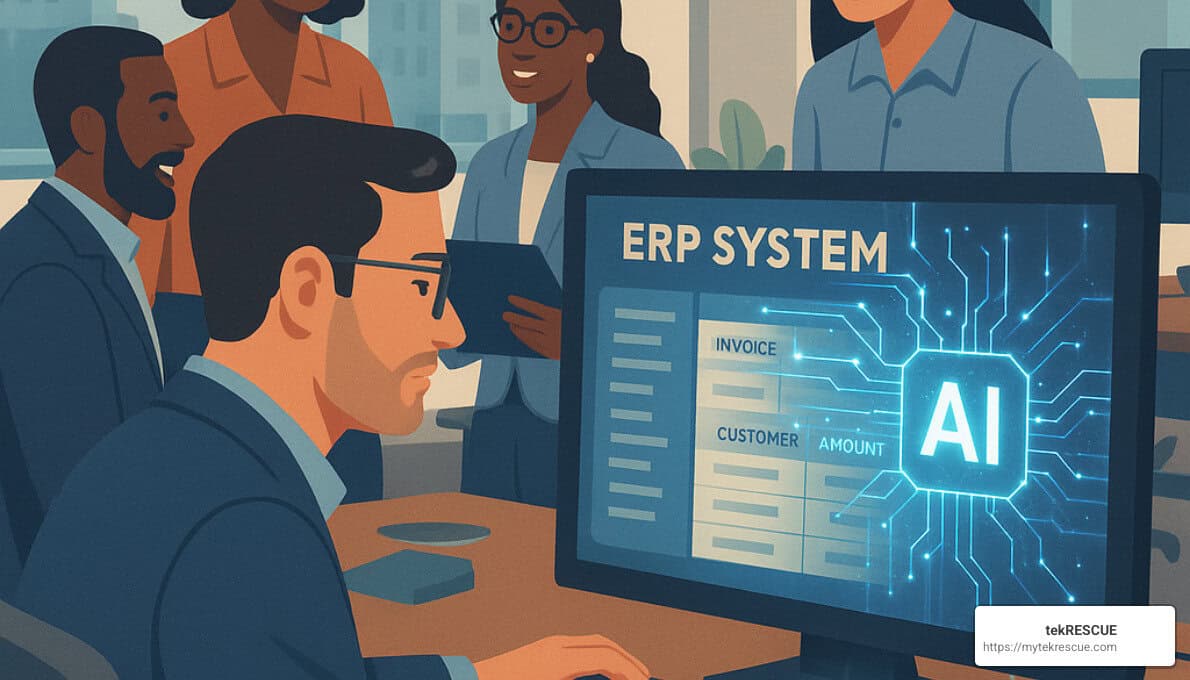
RPA + Machine Learning
Think of traditional RPA as a diligent worker who follows instructions perfectly—until something unexpected happens. That’s where machine learning comes in, like adding common sense to that worker’s skill set.
When we combine RPA with machine learning, suddenly those software robots can handle document variations (like different invoice formats), make smart decisions based on past patterns, and adapt to changing conditions without needing someone to reprogram them. They can even prioritize work based on business impact and flag unusual items for human review.
A client of ours in manufacturing used to have RPA bots that would crash whenever vendor invoices changed format. After adding machine learning capabilities, those same bots now handle dozens of different invoice layouts without breaking a sweat—saving hours of manual intervention each week.
BPM + Process Mining
Business Process Management platforms are great for designing workflows, but they’ve traditionally relied on how we think processes work. The reality is often messier. By adding AI-powered process mining to BPM, we transform static diagrams into living, breathing insights.
These improved systems automatically find actual processes from system logs, identify bottlenecks as they form, and even recommend improvements based on real data. One healthcare organization we worked with finded that their patient intake process had 12 more steps than they thought—steps that were causing significant delays but weren’t documented anywhere.
With AI business process automation, process improvement becomes continuous rather than a once-a-year project. The system is constantly learning, adapting, and suggesting better ways to work.
Orchestration Platforms
Modern process orchestration platforms serve as the “central nervous system” for your automation ecosystem. They coordinate everything—humans, systems, and AI components—ensuring everyone and everything works together smoothly.
These platforms provide end-to-end visibility into complex processes, manage exceptions intelligently, and maintain comprehensive audit trails for compliance. They’re also incredibly adaptable, allowing quick reconfiguration as business needs change.
As one of our clients put it: “Our orchestration platform is like having an air traffic controller for our business processes—everything runs more smoothly when there’s someone making sure all the pieces work together.”
Low-Code Development
The traditional software development cycle is too slow for today’s business needs. Low-code platforms democratize automation by allowing business users to create sophisticated applications with minimal coding.
When improved with AI, these platforms become even more powerful. They can generate application components from simple descriptions, automatically create data models, and even suggest improvements based on how people use the applications.
This means your marketing team can create their own customer journey automation without waiting months for IT resources. Your finance department can build automated reporting tools that adapt to changing requirements. The possibilities are endless, and the time-to-value is measured in days rather than months.
Document Understanding
For many businesses, unstructured information is where the real value—and the real headaches—live. Contracts, emails, reports, and forms contain critical information, but extracting it manually is time-consuming and error-prone.
AI-powered document understanding transforms this landscape by automatically extracting structured data from unstructured documents, classifying documents, summarizing long texts, and identifying key clauses. One legal team we worked with reduced contract review time by 70% using these technologies, allowing them to focus on strategic issues rather than searching for specific clauses.
If you’re looking to build a solid foundation for your AI business process automation journey, consider exploring our IT infrastructure optimization services. The right infrastructure makes all the difference in how smoothly your automation initiatives will run.
ai business process automation Tool Selection Checklist
Choosing the right automation platform is critical to your success. When evaluating options, consider these key factors:
Integration Depth: The best automation tool in the world won’t help if it can’t connect with your existing systems. Look for pre-built connectors to your critical applications.
Data Privacy: With growing privacy regulations, ensure the solution protects sensitive information appropriately. This is especially important if you’re in healthcare, finance, or other regulated industries.
Scalability: Your business will grow and change. Make sure your automation platform can grow with you without requiring a complete rebuild.
Total Cost of Ownership: Look beyond the initial price tag to understand ongoing costs for licenses, maintenance, and required expertise.
Security: Automation often involves sensitive data and critical processes. Robust security isn’t optional—it’s essential.
Vendor Support: The quality of training, implementation assistance, and ongoing support can make or break your automation initiative.
By thoroughly evaluating platforms against these criteria, you’ll be more likely to select a solution that delivers sustainable value rather than becoming yet another underused technology investment.
Real-World Use Cases Across Industries
AI business process automation isn’t just theoretical—it’s already changing how businesses operate across virtually every sector. Let’s explore some of the most impressive real-world applications that are delivering measurable results.
Financial Services – Intelligent Underwriting & Fraud Detection
In the financial world, AI is revolutionizing processes that once took days or even weeks to complete.
Banking and insurance professionals now rely on AI-powered systems for credit scoring that goes far beyond traditional models. These systems analyze not just standard financial data but also alternative sources to build a more complete picture of creditworthiness.
The KYC (Know Your Customer) process has been particularly transformed. What once required mountains of paperwork and days of waiting now happens in minutes through automated document verification and identity checks.
Perhaps most impressively, fraud detection has taken a quantum leap forward. Rather than relying on rigid rules that fraudsters quickly learn to circumvent, AI systems continuously monitor transactions for suspicious patterns, adapting their models as new fraud techniques emerge.
One major bank I worked with implemented an AI-powered loan processing system that cut their approval times by a remarkable 80%. At the same time, they actually improved their risk assessment accuracy by analyzing both traditional data points and unstructured information like social media activity and business news.
HR – Smart Talent Acquisition & Onboarding
Human Resources departments are finding that AI business process automation transforms their ability to find and develop talent.
The tedious process of reviewing resumes has been streamlined through AI systems that can extract relevant information and match candidates to job requirements with surprising accuracy. Interview scheduling, once a nightmare of back-and-forth emails, now happens automatically with systems that coordinate calendars across candidates and hiring managers.
New employee onboarding has been reimagined with intelligent workflows that guide fresh hires through paperwork, training modules, and team integration steps. Meanwhile, performance analysis tools identify patterns that might escape human notice, suggesting personalized development opportunities.
A global consulting firm recently shared with me that their AI-driven recruitment platform reduced their time-to-hire by an impressive 62%. More importantly, their candidate quality scores actually improved, proving that faster doesn’t have to mean less thorough.
For businesses looking to ensure their technology investments support broader strategic goals, our MSP alignment services can help create that crucial connection between automation initiatives and business objectives.
Supply Chain – Predictive Demand & Inventory Optimization
Supply chain operations have perhaps benefited more from AI business process automation than any other business function.
The traditional approach to demand forecasting was often more art than science, but AI systems now analyze historical data, market trends, and even seemingly unrelated factors like weather patterns to predict future demand with remarkable accuracy. This feeds directly into inventory optimization systems that keep stock levels just right—not too much (which ties up capital) and not too little (which risks stockouts).
Logistics planning has been transformed through AI that optimizes routing and scheduling in ways human planners simply couldn’t manage. And supplier management, once a hodgepodge of emails, phone calls, and spreadsheets, now flows through automated workflows that keep everyone informed.
According to recent McKinsey research, AI typically reduces forecasting errors by 30-50% in supply chain management. One consumer products company I consulted with implemented AI-driven supply chain automation that cut inventory costs by 15% while simultaneously improving on-time delivery by 23%—a win-win that demonstrates the power of these systems to optimize multiple objectives simultaneously.
For more insights on how AI is changing supply chains, check out this fascinating scientific research on supply-chain AI.
Customer Service – Conversational AI & Sentiment Routing
The customer service experience has been completely reimagined through AI business process automation.
Gone are the days of frustrating IVR menus and long hold times. Today’s intelligent chatbots handle routine inquiries around the clock, understanding natural language and responding appropriately. Behind the scenes, sentiment analysis detects customer emotions, automatically escalating conversations when frustration is detected.
Ticket routing, once a manual process prone to errors and delays, now happens instantly with AI directing issues to the most appropriate agent or department. And knowledge bases stay fresh through systems that automatically update documentation based on successfully resolved issues.
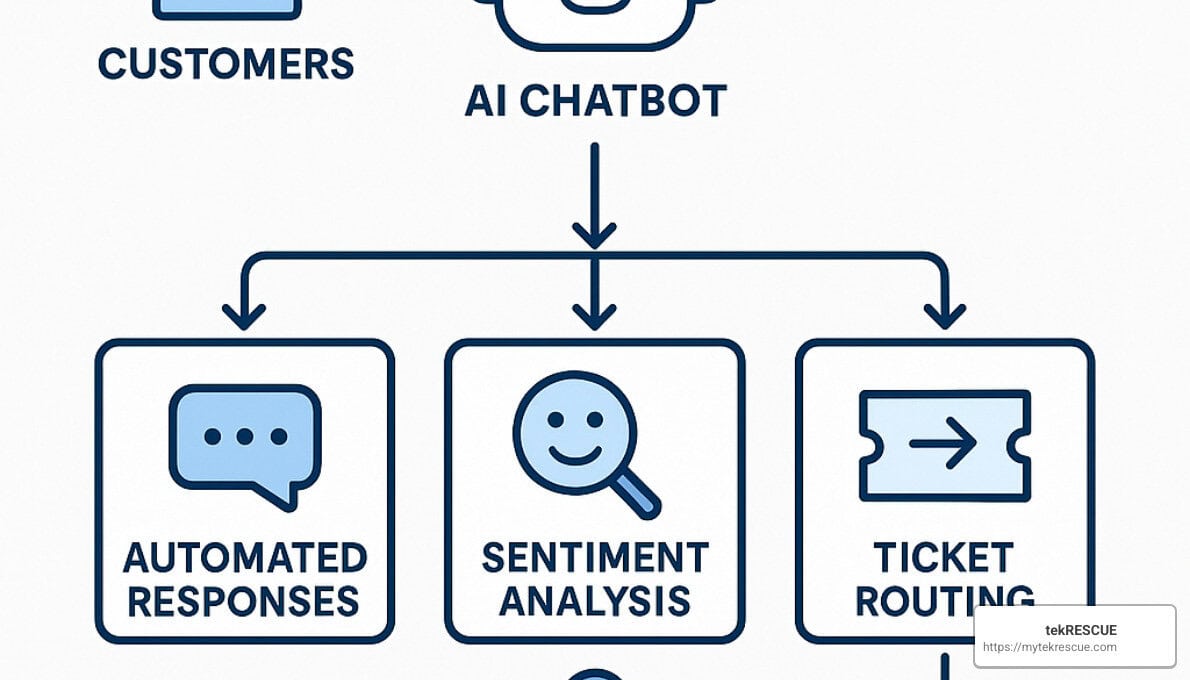
A telecommunications provider I worked with recently deployed conversational AI that now handles a whopping 68% of customer inquiries without any human intervention. What’s particularly impressive is how the system continues to learn from every interaction, gradually improving its responses over time and knowing exactly when to bring in human agents for complex issues.
The real magic happens when these customer service systems integrate with other business processes, creating truly seamless experiences that span marketing, sales, service, and support—all working together as one cohesive system rather than separate departments.
Implementing AI Business Process Automation: A Step-by-Step Guide
Turning AI automation from a buzzword into business reality doesn’t happen overnight. It’s a journey that requires both technical know-how and thoughtful change management. Let’s walk through how your organization can successfully implement AI business process automation without the headaches that often come with digital change.
1. Process Assessment and Prioritization
Start by looking for the low-hanging fruit in your organization. The best candidates for automation usually share some common traits:
Not every process deserves to be first in line for automation. Look for processes that are repetitive, rule-based, and high-volume. These might include invoice processing, data entry tasks, or customer onboarding workflows that currently consume hours of your team’s time.
I’ve seen companies make the mistake of trying to automate their most complex processes first. Instead, prioritize based on potential ROI, implementation complexity, and strategic importance. Those early wins will build momentum and executive support for your broader automation initiatives.
2. Data Readiness Evaluation
Your AI system will only be as smart as the data you feed it. Before diving into implementation, take a hard look at your data environment.
Do you have enough historical data for AI to learn from? Is that data clean, consistent, and accessible? Are there integration challenges between your various systems? These questions need answers before you proceed.
Many automation projects stall because organizations find too late that their data is siloed, inconsistent, or simply insufficient. Address these issues upfront by cleaning data sources, establishing integration pathways, and implementing governance frameworks that will support your automation journey.
3. Platform Selection
Choosing the right technology partners is critical. Your selection should align with both your current needs and future ambitions.
Consider factors like integration capabilities with your existing systems, security features, scalability options, and vendor support. Don’t just focus on features—think about the total cost of ownership and how the platform will grow with your business.
You’re not just buying technology; you’re investing in a partnership. Take time to evaluate vendor expertise, customer support, and implementation methodologies before making your decision.
4. Pilot Implementation
Start small, learn fast. A focused pilot project helps you validate your approach while containing risk.
Choose a process that’s important enough to matter but limited enough to manage. Use this pilot to work through technical challenges, measure actual business impact, and build internal expertise. The lessons learned during your pilot will create a roadmap for broader deployment.
One manufacturing client of ours started with automating just their purchase order approvals. Within weeks, they reduced processing time by 70% while eliminating errors—creating an immediate win that built enthusiasm for expanding to other processes.
5. Change Management
The human side of automation is where many implementations succeed or fail. AI business process automation changes how people work, and addressing those concerns proactively is essential.
Be transparent about the goals of automation—emphasize how AI will handle tedious tasks so employees can focus on more rewarding work. Involve team members in process redesign, provide comprehensive training, and celebrate successes to build positive momentum.
As one change management expert puts it: “People don’t resist change; they resist being changed.” When employees help shape the automation journey, they become champions rather than skeptics.
6. Integration and Scaling
Once your pilot proves successful, it’s time to expand. This phase focuses on integrating your automation solution with existing systems and scaling across the organization.
Establish governance frameworks to manage your growing automation portfolio. Consider creating a center of excellence that can share best practices, maintain standards, and provide support to different business units.
The most successful organizations take a methodical approach to scaling, prioritizing processes based on business impact and implementation complexity rather than trying to automate everything at once.
7. Continuous Improvement
AI business process automation isn’t a “set it and forget it” technology. It requires ongoing attention and refinement to deliver maximum value.
Establish clear KPIs to track performance, gather user feedback systematically, and regularly update your AI models with new data. As technology evolves, look for opportunities to incorporate new capabilities or expand to additional processes.
This commitment to continuous improvement ensures that your automation investment delivers sustained value rather than diminishing returns.
For organizations navigating this complex journey, digital change services can provide valuable guidance and support throughout the process.
Overcoming Challenges: Data, Culture, and Compliance
Every automation journey faces obstacles. Here are the most common challenges and how to address them:
Data Quality and Integration often tops the list of implementation problems. When your data lives in disconnected systems with inconsistent formats, AI struggles to deliver results. Consider implementing a data fabric architecture or integration layer before deploying AI to create a unified data environment.
Legacy System Limitations can slow your progress when older systems lack modern APIs. Options include developing custom integration points, using RPA for screen-level integration, or selectively modernizing critical systems that will interact with your AI solution.
Employee Resistance emerges when people fear job loss or major disruption. Combat this by clearly communicating how automation will augment rather than replace employees. Pair this with robust reskilling programs that help team members develop the skills needed in your more automated environment.
Compliance and Governance concerns multiply when AI enters the picture. Establish frameworks that address data privacy, security requirements, potential algorithmic bias, and decision transparency. This is particularly important in regulated industries where AI decisions must be explainable.
Skill Gaps can derail even the most promising automation initiatives. Most organizations lack all the expertise needed to implement and manage AI systems internally. Strategic partnerships, targeted training programs, and selective hiring can help bridge these gaps.
By anticipating and addressing these challenges proactively, you’ll significantly increase your chances of successful implementation.
Measuring Success & ROI in ai business process automation
Demonstrating the value of your automation initiatives requires a comprehensive measurement framework that captures both direct and indirect benefits.
Before implementation, document baseline performance for key metrics like process cycle times, error rates, labor costs, and customer satisfaction scores. These baselines provide the foundation for measuring improvement and calculating ROI.
Look beyond simple cost reduction to capture the full value of your automation investments. While direct cost savings are important, the most significant benefits often come from improved quality, improved customer experience, and increased organizational agility.
One healthcare provider we worked with found that while their AI business process automation initiative reduced processing costs by 40%, the more valuable outcome was a 68% reduction in processing errors that significantly improved patient satisfaction.
Develop a balanced scorecard that tracks operational metrics (cycle time, throughput, error rates), financial impacts (cost savings, revenue growth), customer outcomes (satisfaction, retention), and employee effects (productivity, satisfaction). This comprehensive view provides a complete picture of automation’s impact on your business.
Some benefits take time to fully materialize. Implement a measurement cadence that captures both short-term wins and long-term strategic value to ensure your automation initiative gets the credit it deserves.
For organizations looking to maximize the strategic impact of their AI investments, Strategic AI Consulting can help align automation initiatives with broader business objectives and ensure measurable results.
Frequently Asked Questions about AI Business Process Automation
How is AI BPA different from RPA?
If you’re exploring automation options, you’ve probably wondered about the difference between these two approaches. While they sound similar, they serve different purposes in your business toolkit.
Robotic Process Automation (RPA) is like having a super-reliable employee who follows instructions perfectly but can’t think outside the box. RPA tools excel at repetitive, rule-based tasks where the steps don’t change. They’re great for data entry, form filling, and other structured work.
AI business process automation, on the other hand, brings intelligence to the table. It’s more like having a seasoned colleague who not only follows procedures but also learns from experience, makes judgment calls, and adapts to new situations. These systems can understand unstructured data (like emails or documents), recognize patterns, and make decisions based on what they’ve learned.
Many of our clients start their automation journey with RPA to get quick wins, then gradually add AI capabilities as they grow more comfortable with the technology. The most effective approach often combines both – using RPA for the predictable parts of a process and AI for the elements that require judgment or handling exceptions.
What processes are best suited for AI automation first?
When you’re just starting with AI business process automation, choosing the right initial projects can make all the difference between success and frustration. The best candidates typically share these characteristics:
High volume processes give you more bang for your buck and provide plenty of data for AI systems to learn from. Processes with clear rules at least for portions of the workflow make implementation smoother. You’ll also need sufficient historical data for training your AI systems and well-defined success metrics to demonstrate value. Finally, focus on genuine pain points where improvements will be immediately noticeable.
Many of our clients find success starting with customer service inquiries, invoice processing, employee onboarding, document data extraction, or compliance reporting. These areas often deliver visible improvements quickly, building momentum and support for more ambitious automation down the road.
The goal of your first project isn’t just to save money—it’s to learn, build confidence, and create advocates within your organization. Start small, prove the concept, then expand.
How long until I see ROI from AI BPA initiatives?
This is probably the question we hear most often from business leaders, and the honest answer is: it depends on several factors. But don’t worry—we can get more specific than that!
The timeline for realizing returns varies based on the complexity of the processes you’re automating, your implementation approach, integration requirements with existing systems, the state of your data, and how well your team adapts to the changes.
For focused implementations with clear boundaries, most organizations see initial ROI within 3-9 months. One of our banking clients reduced their annual report generation process from six weeks to under one week by combining process orchestration with AI—achieving ROI within their very first reporting cycle.
Cloud-based solutions typically deliver value faster than on-premises deployments, and processes with clean, accessible data show results sooner than those requiring extensive data preparation.
The most successful organizations take what we call a “portfolio approach”—balancing quick wins that deliver immediate value with more transformative longer-term initiatives. This creates a sustainable funding model where early successes help finance more ambitious projects.
At tekRESCUE, we help clients identify the right mix of short and long-term automation opportunities to maximize both immediate returns and strategic value. Our Strategic AI Consulting services can help you steer the complexities of implementation while keeping a clear focus on business outcomes.
Conclusion
AI business process automation has made the leap from sci-fi concept to business necessity. It’s not just another tech trend—it’s a fundamental shift in how work gets done. Companies embracing these tools are pulling ahead with dramatic improvements in efficiency, reduced costs, better quality, and happier customers.
The beauty of this journey is that it’s not primarily about the technology. The real change happens with your people, processes, and culture. Success doesn’t come from just buying fancy software—it comes from having a clear vision, thoughtful implementation, and a commitment to continuous learning.
What’s truly exciting is how the possibilities keep expanding. With each advancement in generative AI, agentic systems, and hyperautomation, doors open to opportunities that seemed impossible just a few years ago. The pace of innovation isn’t slowing down—it’s accelerating.
For businesses across Texas—whether you’re in San Marcos, Austin, Kyle, Dallas, San Antonio, or beyond—navigating this landscape can feel overwhelming. That’s where expert guidance makes all the difference. At tekRESCUE, we’ve helped organizations of all sizes implement efficiencies that deliver real results. Our Strategic AI Consulting services provide the roadmap you need, from initial assessment through implementation and ongoing optimization.
The question isn’t whether your business should automate—it’s how quickly and effectively you can transform your operations to thrive in this new reality. Tomorrow’s market leaders will be those organizations that find the perfect balance between human creativity and AI-powered efficiency.
Are you ready to begin your automation journey? There’s no better time than now to take that first step.
The future is being written by those bold enough to accept change. Will your business be one of them?
Table of Contents

